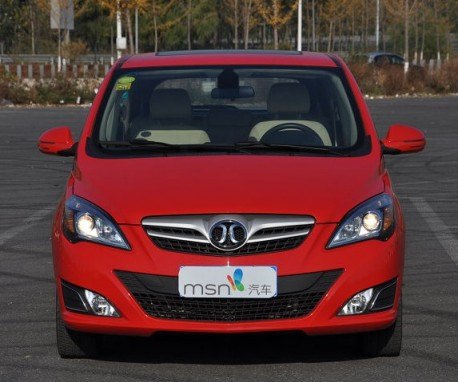Mad In China: How To Get A New Mercedes B-Class For Only $8,680

BAIC and Daimler announced last Friday they are taking the Beijing-Benz joint venture a giant step further. Daimler takes a 12 percent stake in BAIC and both parties will work closely together to win market share from Audi and BMW. On the ‘grass roots level’ the close cooperation has long begun! Above, a Beijing Auto E-Series with a Mercedes-Benz grille. How did that happen?
It started as an E-Series. No, not as an E-Klasse. The Beijing Auto E-Series was launched on the Chinese car market in March last year, priced between 53.800 and 86.800 yuan ($8,600 to $14,000.) This E-Series’ design is inspired by the last generation Mercedes-Benz B-Class, but the car is much smaller. Are we confused yet? No? Bear with me.
The platform however has a real connection to Daimler. The Chinese E-Series that looks like the German B-Series sits on the platform of the failed Smart ForFour that was made from 2004 to 2006. The engines are 1.3 and 1.5 liter Mitsubishi units that came with the platform. (Cue requisite and boring “merger of equals” comments from folks who know that Mitsu was part is the threesome.)
The Beijing Auto E-Series is not made by the Beijing-Benz joint venture, it is produced by Beijing Auto and sold by the Beijing Auto dealer network. Do your part for a sustainable auto business! Recycle a platform!
This is the last generation Mercedes-Benz B-Class. It was imported into China and sold via a then separate ‘imported-Mercedes’ dealer network. BAIC and Daimler only recently agreed to sell the locally produced Beijing-Benz cars and the imported Mercedes cars together, in a new and yet to establish dealer network. The B-Class was priced between 270.000 and 320.000 yuan ($43,300 – $51,400).
Now, how did these rather different vehicles come together?
Enter a fake Mercedes-Benz grille, made to fit the Beijing Auto E-Series.
The grille comes in a neat beige box. The Chinese characters write ‘BeiQi E Series’, BeiQi is short for Beijing Qiche, or Beijing Auto. But! Just a grille isn’t enough to fool grandma these days. Fortunately there is more:
Badges for on the wheels, for on the back, and one for on the steering wheel. ‘E150′ is the Beijing Auto E-Series with the 1.5, the 1.3 is called E130.
If you want to spend a bit more money you can buy wheel covers that look like Mercedes-Benz alloys. Price for the whole set, including the grille, badges and wheel covers: 500 yuan or $80.
Looks a little chintzy, but your grandmother in Inner Mongolia will be impressed.
The badge on the hood doesn’t sit completely straight. This wouldn’t happen to the Germans. It looks more like a “100 Jahre ADAC” badge, but what do we and grandma know.
BAIC and Daimler have their work cut out for them.
Dutchman Tycho de Feyter runs Carnewschina.com, a blog about cars in China, from Beijing, China. He also collects die-cast models of Chinese cars.

More by Tycho de Feyter
Latest Car Reviews
Read moreLatest Product Reviews
Read moreRecent Comments
- Bd2 If I were going to spend $ on a ticking time bomb, it wouldn't be for an LR4 (the least interesting of Land Rovers).
- Spectator Wild to me the US sent like $100B overseas for other peoples wars while we clammer over .1% of that money being used to promote EVs in our country.
- Spectator got a pic of that 27 inch screen? That sounds massive!
- MaintenanceCosts "And with ANY car, always budget for maintenance."The question is whether you have to budget a thousand bucks (or euro) a year, or a quarter of your income.
- FreedMike The NASCAR race was a dandy. That finish…












































Comments
Join the conversation
Geez Chinese people, at LEAST line up the emblems before you glue them down. And also check out other MB products to see they haven't ever used the blue crested symbol on the interior. >.
I had a buddy in college that decided to get a Polo horse tattooed on his chest. After pointing at him and laughing for about 20 minutes, I think he wisely concluded that it wasn't a good idea.